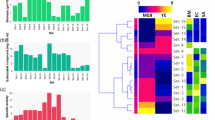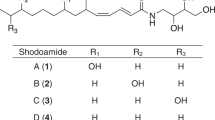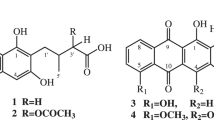Abstract
MANY papers have been published on the antegoniam of certain micro-organisms against acid-fast bacteria, particularly M. tuberculosis1–13. In this connexion the metabolic products of the various strains of the group Aspergillus are receiving considerable attention. Fumigatin14, spinulosin15, helvolic acid16 and gliotoxin17 are the four metabolic products of A. fumigatus which show considerable antibiotic activity. The present communication relates to a study of the formation of antibiotic activity and the source of nitrogen by A. fumigatus, Fresenius, The strain of this organism was obtained from the Imperial Institute of Agricultural Research, New Delhi, isolated by Mr. G. Smith of the London School of Tropical Medicine.
This is a preview of subscription content, access via your institution
Access options
Subscribe to this journal
Receive 51 print issues and online access
$199.00 per year
only $3.90 per issue
Buy this article
- Purchase on Springer Link
- Instant access to full article PDF
Prices may be subject to local taxes which are calculated during checkout
Similar content being viewed by others
References
Vaudremer, A., C.R. Soc. Biol., 73, 51 (1912); 74, 278, 752 (1913).
Schiller, I., Zbl. Bact., Abt. I, Orig., 96, 54 (1925).
Barglowski, D., Amer. Rev. Tub., 38, 393 (1938).
Zorzoli, G., Amer. Inst. Carlo. Forlanini., 4, 208 (1940), abstr. Vet. Bull., 11, 833 (1941).
Soltys, M. A., Nature, 154, 550 (1944).
Kurung, J. M., Science, 102, 11 (1945).
Kallós, P., Nature, 155, 300 (1945).
Miller, D. K., and ReKate, A. C., Science, 100, 172 (1944).
Asheshov, I. N., and Strelity, F., Science, 101, 119 (1945).
Gerber, I. E., and Gross, M., Science, 101, 616 (1945).
Schatz, A., et al., Proc. Soc. Exp. Biol. Med., 55, 66 (1944).
Smith, M. I., and Emmart, E. W., Pub. Health Rep., 59, 417 (1944).
Hogeboom, G. M., and Craig, L. C., J. Biol. Chem., 162, 363 (1946).
Anslow, W. K., and Raistrick, H., Biochem. J., 32, 687 (1938).
Anslow, W. K., and Raistrick, H., Biochem. J., 32, 2288 (1938).
Chain, E., et al., Brit. J. Exp. Path., 24, 108 (1943).
Menzel, A. E., et al., J. Biol. Chem., 152, 419 (1944).
Foster and Woodruff, J. Bact., 47, 43 (1944).
Rao and Venkataraman, communicated for publication in J. Coun. Sci. and Ind. Res. (India).
Cook et al., Biochem. J., 39, 314 (1945).
Author information
Authors and Affiliations
Rights and permissions
About this article
Cite this article
RAO, R., VENKATARAMAN, P. Relations between the Source of Nitrogen and Antibiotic Formation by Aspergillus Fumigatus, Fresenius. Nature 158, 241–242 (1946). https://doi.org/10.1038/158241a0
Issue Date:
DOI: https://doi.org/10.1038/158241a0
This article is cited by
Comments
By submitting a comment you agree to abide by our Terms and Community Guidelines. If you find something abusive or that does not comply with our terms or guidelines please flag it as inappropriate.



